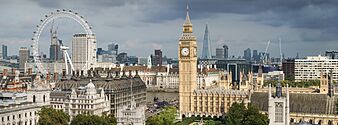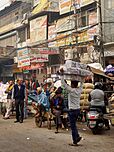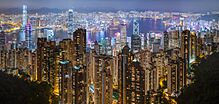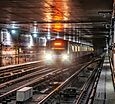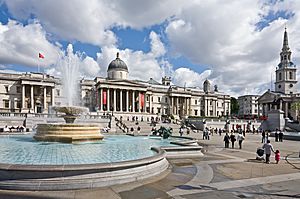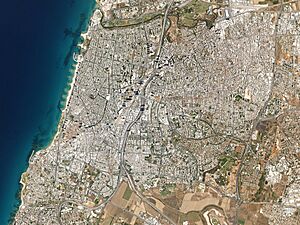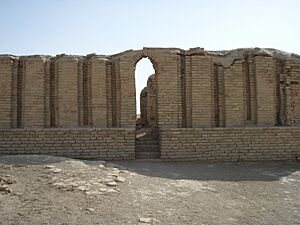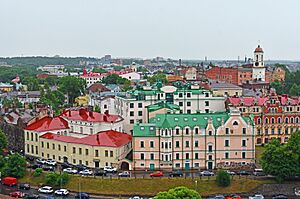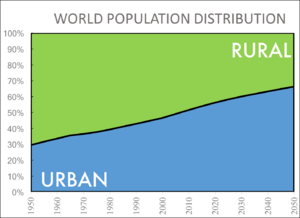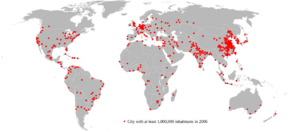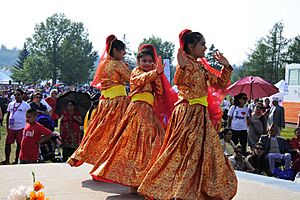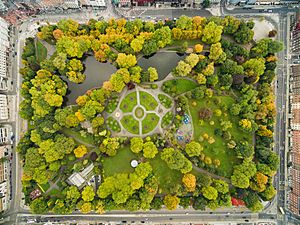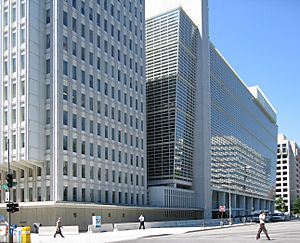City facts for kids
A city is a large human settlement where many people live and work. Cities are usually very busy places with lots of buildings, roads, and people. They have systems for housing, transportation, sanitation (like sewers), and utilities (like electricity and water). Cities also have places for making goods and for people to communicate. Because so many people live close together, it's easier for them to interact, which helps businesses and governments work better.
For a long time, most people lived in the countryside. But over the last 200 years, more and more people have moved to cities. Now, over half of the world population lives in cities! This big change has a huge impact on our planet's sustainability. Today's cities are often the main part of larger metropolitan areas, which include suburbs and nearby towns. Many people travel from these areas to the city centre for work, fun, and school.
Cities around the world are also connected to each other more than ever before. This means they play a big role in solving global problems like sustainable development, climate change, and global health. Because cities are so important, the United Nations has made it a goal to create sustainable cities (Sustainable Development Goal 11). Cities can actually be good for the environment because they use less land per person than spread-out areas. This is why "compact cities" are seen as important in fighting climate change. However, having so many people in one place can also cause problems like urban heat islands (cities getting hotter than nearby rural areas), pollution, and stress on water supplies.
Contents
What is a City?
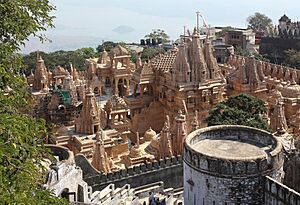
A city is different from other places where people live, like towns or villages, because of its size and what it does. It also often has a special official title given by a government. The word "city" can mean the buildings and streets, or it can mean the people who live there. It's often used to describe an urban (city-like) place, rather than a rural territory (countryside).
Different countries have different ways to decide what counts as a city. They might look at how many people live there, how crowded it is, how many homes there are, what kind of jobs people do, or what infrastructure (like roads and pipes) it has. For example, in the United Kingdom, a place gets "city status" from the King or Queen, and it stays a city forever. Historically, a place became a city if it had a cathedral, which is why some very small places like Wells (population 12,000) and St Davids (population 1,841) are called cities.
Cities are not just big; they also serve important roles. They are often centers for government, business, religion, and culture for the areas around them. Cities usually have professional administrators and rules, and they collect taxation to support government workers. This is different from a village where people might work together based on informal agreements. Societies that live in cities are often called civilizations.
A modern way to define a city is by looking at its "degree of urbanization." This means a place with at least 50,000 people living closely together (more than 1,500 people per square kilometer). This definition helps countries compare cities around the world.
Where Does the Word "City" Come From?
The word city and civilization come from the Latin word civitas. This word first meant 'citizenship' or 'community member'. Later, it came to mean a physical 'city', like the Latin word urbs. The Roman civitas was similar to the Greek polis, which is also found in English words like metropolis (a very large city).
City Geography
Urban geography is the study of cities, both how they fit into the larger world and how they are organized inside. Cities cover about 3% of the Earth's land.
Why Cities are Built Where They Are
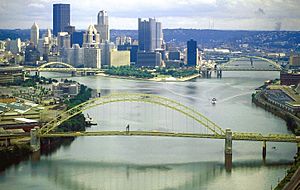
The location of cities has changed over time, depending on nature, technology, money, and military needs. Access to water has always been very important. Most cities today are still near coasts or rivers, even with modern transportation.
Cities usually cannot grow their own food. So, they need to have a connection with the surrounding countryside (called a hinterland) that provides them with food. Cities also tend to grow in places that are good for trade and business.
The City Center

Most cities have a main area with important buildings for business, government, and religion. In ancient times, these areas were often called a temenos or a citadel if they were fortified. Today, cities have a city center or downtown, which is often also the main business area.
Public Spaces in Cities
Cities usually have public spaces where everyone can go. These include parks, squares, and other open areas. These spaces are important for people to gather, relax, and enjoy nature within the city. Urban green spaces like parks also help keep cities cooler and improve air quality.
How Cities are Laid Out
The way a city is built often follows certain patterns. The natural environment can shape a city; for example, a city on a mountainside might have winding roads. Cities can also be planned.
- Radial Structure: In this pattern, main roads spread out from a central point, like spokes on a wheel. Cities like Amsterdam and Moscow show this pattern, sometimes with old city walls forming rings around the center.
- Grid Plan: This is a system of straight streets that cross each other at right angles, like a checkerboard. This pattern has been used for thousands of years in places like the Indus Valley Civilization (Mohenjo-Daro) and ancient Greek cities. Washington, D.C. is a modern example.
Larger Urban Areas
Cities often grow far beyond their original borders, creating what is sometimes called urban sprawl. This means that city activities like shopping, factories, and homes spread out.
Metropolitan areas include the main city plus its suburbs and other surrounding areas. These areas are connected by people traveling to and from the city for work. Sometimes, several large urban areas grow together to form a huge continuous urban landscape called a conurbation or even a megalopolis. An example is the "BosWash" corridor in the Northeastern United States, which stretches from Boston to Washington, D.C.
City History
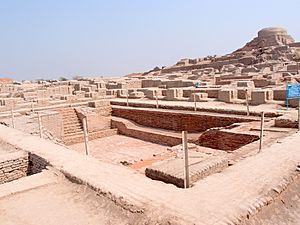
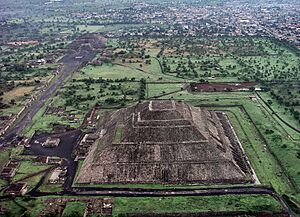
Cities have been around for thousands of years. They usually started after people learned to farm, which created extra food. This allowed some people to do jobs other than farming, leading to different types of workers and trade. Early cities often had places to store grain, sometimes inside temples.
Some of the oldest continuously inhabited cities include Jericho, Aleppo, and Damascus.
Ancient Cities
The Mesopotamian city of Uruk (in ancient Iraq), from around 3500 BC, is often considered the first true city. It had many features that later cities would copy.
In ancient times (around 3000-2000 BC), advanced civilizations grew in river valleys like Mesopotamia, India, China, and Egypt. Their cities were built for trade, politics, or religion. Some were very crowded, while others were important for their political or religious roles, even if they weren't huge.
Mohenjo-daro in present-day Pakistan, part of the Indus Valley civilization (around 2600 BC), was one of the largest early cities. It had a population of 50,000 or more and a very advanced sewer system. Ancient Chinese cities were planned based on sacred ideas.
In Mesopotamia, civilizations like Sumer, Assyria, and Babylon built many cities ruled by kings. The Phoenicians, who were great traders, had many cities along the Mediterranean Sea.
In Ancient Greece, independent city-states like Athens developed the polis, where male landowners were citizens who made up the city. The agora was the center of city life. Rome was the first city to have over a million people. The Roman Empire also built many new cities, bringing its ideas of city design and society with them.
In the ancient Americas, early cities developed in places like the Andes Mountains and Mesoamerica (parts of Mexico and Central America). The Norte Chico civilization in Peru, around 3000-1800 BC, had about 30 major population centers. Mesoamerica saw cities rise with the Olmec, Maya, and Aztec cultures. Many ancient cities, like Tenochtitlan (now Mexico City), are still inhabited today.
In West Africa, cities like Dhar Tichitt (Mauritania) and Dia (Mali) showed early signs of city life around 1000 BC. Later, Jenné-Jeno (Mali), from the 3rd century BCE, was also an important early city, known for its specialized production and trade.
Cities in the Middle Ages

After the Roman Empire declined, cities in Western Europe became less important. But in the East, Constantinople (now Istanbul) became the largest and richest city in Europe, with almost a million people. The Islamic world also saw great cities like Baghdad, Cairo, and Córdoba grow.
In Europe, some cities became very powerful. In Italy, cities like Venice and Genoa became independent city-states. In Northern Europe, cities like Lübeck and Bruges formed the Hanseatic League to protect their trade.
The Khmer Empire capital of Angkor in Cambodia grew to be the largest pre-industrial city in the world by area, covering over 1,000 square kilometers and possibly supporting up to a million people.
West Africa also saw many large cities grow during the Middle Ages, especially with the rise of Trans-Saharan trade. Cities like Gao, Oyo-Ile, Ile-Ifẹ̀, Niani, and Timbuktu became very populous and important trade centers.
Early Modern Cities
In the early modern period (after the Middle Ages), large capital cities like London and Paris grew because of increased trade across the Atlantic Ocean. When Spain colonized the Americas, they used the old Roman idea of city planning to build new cities in the conquered lands.
Cities in the Industrial Age
The Industrial Revolution (starting in the late 1700s) led to huge growth in cities. New factories created many jobs, drawing huge numbers of people from farms to urban areas. London became the capital of a global empire, and other cities in England grew around factories. In the United States, railroads helped cities grow by making it easier to transport goods and people.
However, this rapid growth also brought problems. Many industrial cities faced health issues due to overcrowding, dirty water and air, and poor sanitation. Factories and slums (very poor, crowded neighborhoods) became common parts of city life.
Cities Today
In the second half of the 1900s, many Western cities saw factories close down. This led to poverty and urban decay (cities falling apart). For example, America's "Steel Belt" became the "Rust Belt" as industries declined. These cities then tried to shift to a service economy (jobs like healthcare, education, and finance). Meanwhile, countries like China saw massive urbanization and industrial growth, becoming the world's leading manufacturer.
Today, new technologies like high-speed internet allow some cities to become centers of the "knowledge economy." There's also a new idea of "smart cities" that use computers and data to manage city services. Some companies are even building brand-new, planned cities from scratch.
Urbanization: More People in Cities
Urbanization is the process of people moving from rural (countryside) areas to urban (city) areas. This is driven by many factors, including jobs, money, and culture. Before the 1700s, there was a balance between people living on farms and people living in towns. But after the agricultural and industrial revolutions, city populations grew incredibly fast. In England, the percentage of people living in cities jumped from 17% in 1801 to 72% in 1891. By 1900, 15% of the world's population lived in cities. Cities also attract people because of their cultural activities and opportunities.
Urbanization quickly spread across Europe and the Americas. Since the 1950s, it has also grown rapidly in Asia and Africa. In 2014, for the first time ever, more than half of the world's population lived in cities.
Latin America is the most urban continent, with 80% of its people living in cities. Some of the fastest-growing cities in the world are in Indonesia, Somalia, China, and Niger. While richer countries in the "Global North" are more urbanized, the difference is shrinking because urbanization is happening faster in the "Global South" (less developed countries). Asia has the most city dwellers, with over two billion people. The UN predicts that by 2050, another 2.5 billion people will live in cities, mostly in Asia and Africa.
Megacities are cities with populations of many millions. They are growing rapidly, especially in Asia, Africa, and Latin America. This growth is fueled by global business, as new money comes in and large companies move their operations, attracting people from all over. These cities often have a big gap between the rich and the poor. A small group of very wealthy people might live in fancy, secure neighborhoods, while many others live in poor housing with few services.
As cities grow in population, they also expand physically. They build more high-rise buildings for homes and businesses, and even develop underground spaces. This rapid growth can put a lot of stress on water resources management, leading to water shortages and pollution.
City Life and Society
How People Live in Cities
City society often has different social groups. Cities can be separated by ethnicity, wealth, and race, either officially or unofficially. People who live close by might work and play in different areas and spend time with different groups. This can create ethnic neighborhoods or, in very poor areas, ghettoes. In the US, poverty is often linked to the inner city, while in France, it's linked to the banlieues (urban areas surrounding the city). Wealthier people often choose to live in gated communities or exclusive neighborhoods.
City Economics

Historically, cities relied on farms in rural areas for food. In return, cities provided money, government, manufactured goods, and culture. Urban economics looks at how money and jobs work in large urban areas, even beyond the city limits.
Cities have always been centers for trade and retail shopping. In the 1900s, department stores used new ways of advertising and design to make shopping an exciting experience.
Because cities are so dense, it's easier for businesses to trade and for people to share ideas. A larger job market means better matches between companies and workers. Sharing infrastructure also helps. However, in very crowded cities, long waits and traffic can cause problems.
While manufacturing helped cities grow, many now rely on a service economy. This includes jobs in tourism, hotels, entertainment, and professional services like law and finance. Studies show that when a city doubles in size, salaries per person generally increase by 15%.
Culture and Communication in Cities
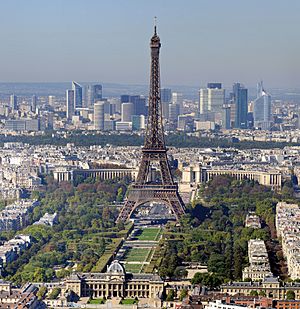
Cities are usually centers for education and the arts. They have universities, museums, temples, and other cultural institutions. Cities are known for their impressive architecture, from small buildings to huge skyscrapers that can be seen from far away. People who are leaders in culture often live in cities. Because cities are centers of culture and learning, they are seen as important places for civilization, human history, and social change.
The density of cities makes it easy to share news and information quickly, through newspapers and digital media. Even though these communication networks use cities as hubs, they reach everywhere.
Today, cities promote their cultural activities to attract businesses, investors, residents, and tourists. This helps create a shared identity and a sense of place for people living there. Some cities, like Jerusalem, Mecca, and Rome, are important religious sites and attract pilgrims. Tourists visit places like Agra to see the Taj Mahal or New York City to see the World Trade Center.
Cities also use sports to build local identity. Cities often compete to host big events like the Olympic Games, which bring global attention and tourism. Paris, a city famous for its culture, hosted the most recent Olympics in 2024.
Cities and Conflict

Cities are very important in conflicts because they are centers of money, people, and government. For this reason, they are often targets. Many cities throughout history were built with military purposes in mind and included fortifications (defensive walls).
During World War II, some cities were declared "open cities" to avoid damage and fighting. However, urban warfare (fighting in cities) was very important in battles like the Battle of Stalingrad, where Soviet forces fought German occupiers. This led to many casualties and destruction.
Sometimes, conflicts can lead to a city's complete destruction. Ancient tablets and ruins show such destruction, and the Latin phrase Carthago delenda est ("Carthage must be destroyed") shows this idea. Since the atomic bombings of Hiroshima and Nagasaki in World War II, people have thought about using nuclear weapons to destroy enemy cities.
Cities and Climate Change
Cities play a big role in climate change. They are major sources of greenhouse gases, which cause global warming. However, cities can also be part of the solution by becoming more sustainable and using less energy.
City Infrastructure

[[Urban infrastructure]] refers to the physical systems and spaces a city needs to work. This includes transportation, water, energy, and public services. Building infrastructure is very expensive at first, but it helps the city's economy grow and allows people to survive. Many infrastructure systems are like networks with multiple paths, so if one part fails, the whole system can still work.
Large projects like building airports or power plants need a lot of money, often from the national government or private companies.
Ideally, city infrastructure serves everyone equally. However, in reality, some areas or groups of people might have better access to services than others.
City Utilities
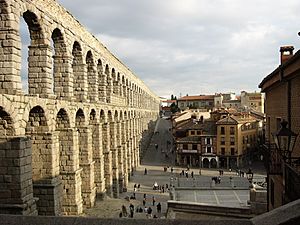
Public utilities are basic services that everyone needs, like water, electricity, and phone/internet.
Sanitation is very important for health in crowded cities. It includes water supply, waste management (like trash collection), and personal hygiene. City water systems include pipes for clean water and sewerage systems for wastewater and rainwater. Historically, local governments or private companies managed water. Today, two French companies, Veolia Water and Engie, manage most private water services worldwide.
Modern city life depends a lot on electricity for homes, businesses, and traffic lights. Cities also use hydrocarbon fuels like gasoline and natural gas for transportation, heating, and cooking. Telecommunications infrastructure, like phone and internet cables, also forms dense networks throughout cities for communication.
City Transportation
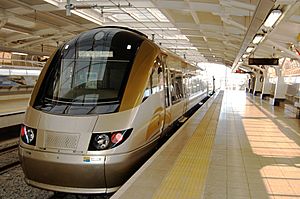


Because people in cities have specialized jobs, they need to travel regularly between home, work, shops, and entertainment. People travel by walking, biking, or using rapid transit systems like subways or elevated trains. Cities also rely on long-distance transportation (trucks, trains, airplanes) to connect with other cities and rural areas.
In the past, city streets were mostly for horses and pedestrians. Later, bicycles became popular. In the early 1900s, public transit systems like streetcars helped cities grow by allowing people to live further from work.
Since the mid-1900s, cities have relied heavily on motor vehicles. This changed how cities were designed, leading to more highways and wider streets. However, this also caused traffic jams.
The bus system is the most common form of public transport. Some cities have bus rapid transit systems with special bus lanes to make travel faster. Many big cities, like New York City, still have popular subway systems. Rapid transit is widely used in Europe, Latin America, and Asia.
Now, Walking and cycling are becoming more popular in city planning. Cities are creating more pedestrian zones and bike lanes to encourage healthier and more sustainable travel. Some cities are even trying to limit car traffic using methods like charging for road use.
City Housing
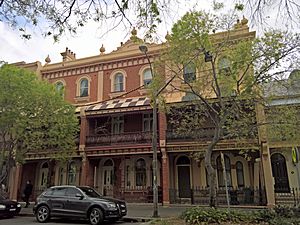
Providing homes for residents is a big challenge for every city. Good housing means not just a place to live, but also the systems needed for life and work.
Owning a home can provide stability, but renting can take up a lot of money for low-wage workers. Homelessness, or not having a home, is a problem faced by millions of people worldwide. Because cities are so crowded, people are more likely to live in apartments than in single-family homes.
City Environment
City environments are very different from the countryside because of all the buildings and human activities. Buildings and waste create unique physical and chemical conditions. Cities can even have special biodiversity (different types of plants and animals) because new species move in. Construction and human activity often disturb habitats, allowing new plants and animals to grow. Overall, city environments are less complex than natural ones.
Common city animals include insects, rodents (like mice and rats), and birds, as well as cats and dogs. Large predators are rare.
Cities create a large ecological footprint (the impact on the environment) because of their large populations and activities. From one point of view, cities are not environmentally sustainable because they use so many resources. But with good management, cities can reduce their negative effects. Air pollution comes from burning things like wood, coal, and fuel in cars. Industrial cities, and today's large cities in developing countries, are known for smog (haze) that can harm people's health. City soil often has higher levels of heavy metals like lead.
Modern cities create their own microclimates (small, local climates). Concrete and asphalt surfaces heat up in the sun and send rainwater into underground pipes. For example, New York City is usually 2–3°C warmer than nearby rural areas, and sometimes even 5–10°C warmer. This is called the urban heat island effect. Air pollution can also increase rainfall. So, cities have unique climates, with plants flowering earlier and losing leaves later than in the countryside.
Poor people and working-class people often face more environmental risks. For example, less-vegetated poor neighborhoods get hotter and have fewer ways to cope with the heat.
One way to improve the urban ecology is to add more urban green spaces like parks, gardens, and trees. These areas improve the health of people, animals, and plants in cities. Studies show that spending at least two hours a week in nature can make people happier and healthier. This applies to everyone, regardless of age, gender, or background. Even visiting local city parks can be very beneficial.
Cities in the World System
As the world becomes more connected through business, politics, technology, and culture (a process called globalization), cities are playing a bigger role in global affairs. This is not new; it can be traced back to the Silk Road and ancient Greek city-states. Today, high-speed internet makes it easy to communicate instantly around the world, connecting cities for international markets and personal communication.
Global Cities
A global city is a very important center for trade, banking, finance, and new ideas. The term "global city" was used by Saskia Sassen in 1991 to describe a city's power, status, and international feel, rather than just its size. Global cities are at the top of the global hierarchy, controlling a lot of economic and political influence. They might have become global cities because they were early to shift to a service-based economy or because they have kept their importance from the industrial age. This idea suggests that cities compete with each other globally to be successful.
Some people criticize this idea, saying it focuses too much on money and doesn't consider other important aspects of a city.
Large international companies and banks often have their main offices in global cities. This is where a lot of international business happens.
Global cities often have a big gap between rich and poor. Rules about immigrants can sometimes lead to unfair working conditions for low- and high-skilled workers from poorer areas.
Cities Working Together Globally
Cities are increasingly involved in global politics on their own, separate from their countries. An early example is the "sister city" relationship, where cities in different countries form partnerships. Cities like Hamburg and London even have their own offices in Brussels to work with the European Union.
Many new city residents are "transmigrants," meaning they stay connected to both their old and new homes, often through technology.
Global City Governance
Cities take part in global governance (how the world is managed) by joining global networks that share rules and ideas. United Cities and Local Governments (UCLG) is a big organization for cities worldwide. Regional groups like Eurocities do similar work. UCLG helped create "Agenda 21 for culture," a plan for cultural policies that support sustainable development.
City networks are especially common for environmental issues and climate change. Examples include the C40 Cities Climate Leadership Group and ICLEI – Local Governments for Sustainability.
Cities with global political status are also meeting places for advocacy groups, non-governmental organizations, and businesses that want to influence world policy. This also makes them places for protests. For example, in Pretoria, South Africa, thousands of people protested for higher wages.
The United Nations and Cities

The United Nations System has held many events and made declarations about city development as cities grow rapidly.
- The Habitat I conference in 1976 said that managing cities is key to development.
- In 1992, the Earth Summit in Rio de Janeiro led to Agenda 21, a plan for sustainable development.
- The Habitat II conference in 1996 asked cities to lead in this plan, which helped with the Millennium Development Goals and Sustainable Development Goals.
- In 2002, the UN created UN-Habitat to coordinate UN activities related to housing and settlements.
- The Habitat III conference in 2016 focused on a "New Urban Agenda" for sustainable cities.
UN-Habitat works with other UN groups like the UN Environmental Programme and the World Health Organization to coordinate the UN's urban plans.
The World Bank, a UN agency, has been important in promoting the Habitat conferences. It uses their declarations to give loans for city infrastructure. The World Bank and UN-Habitat also created the Cities Alliance to help with urban poverty.
UNESCO (United Nations Educational, Scientific and Cultural Organization) also focuses on cities. It has created networks like the Creative Cities Network and can choose World Heritage Sites, which helps with tourism and preserving history.
Cities in Culture

Cities are very important in traditional Western culture, appearing in the Bible as both evil (Babylon) and holy (Jerusalem). In Sumerian stories, Gilgamesh built the walls of Uruk.
Cities can be seen in extreme ways: as places of freedom or oppression, wealth or poverty, order or chaos. Some people are "anti-urban," meaning they don't like cities, perhaps because they see them as places of oppression or where the rich rule. These ideas influence how we talk and write about cities. Cities often symbolize the societies they belong to.
Writers, painters, and filmmakers have created countless works about city life. Classical and medieval literature often described city features and history. Modern authors like Charles Dickens and James Joyce are famous for their vivid descriptions of their home cities. Fritz Lang got the idea for his famous 1927 film Metropolis after seeing the bright lights of Times Square at night. Early movies often showed cities as efficient places with smooth transportation. But by the 1960s, films started showing traffic congestion in cities.
Books and movies have also shown us visions of future cities, both perfect (utopia) and terrible (dystopia). The idea of growing, connected world cities has led to concepts like "Nylonkong" (New York, London, Hong Kong) and visions of a single global city covering the whole Earth.
Images for kids
-
Map of Piraeus, designed according to the Hippodameian grid plan
-
The city hall in George Town, Malaysia, is the main building for the Penang Island City Council.
-
Warsaw Old Town after the Warsaw uprising with 85% of the city destroyed.
See also
 In Spanish: Ciudad para niños
In Spanish: Ciudad para niños


